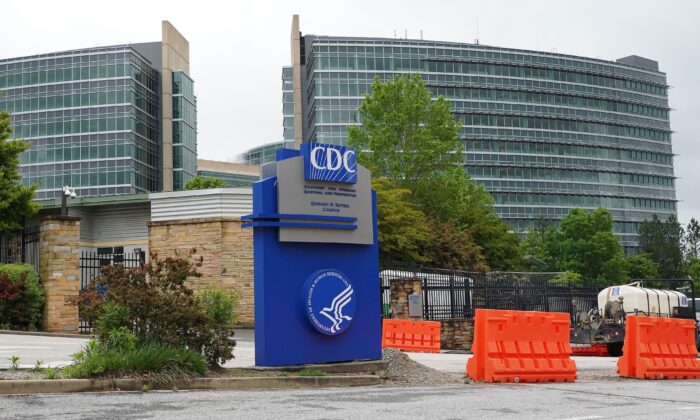Many CDC Blunders Exaggerated Severity of COVID-19: Study

The U.S. Centers for Disease Control and Prevention (CDC) made at least 25 statistical or numerical errors during the COVID-19 pandemic, and the overwhelming majority exaggerated the severity of the pandemic, according to a new study.
Researchers who have been tracking CDC errors compiled 25 instances where the agency offered demonstrably false information. For each instance, they analyzed whether the error exaggerated or downplayed the severity of COVID-19.
Of the 25 instances, 20 exaggerated the severity, the researchers reported in the study, which was published ahead of peer review on March 23.
“The CDC has expressed significant concern about COVID-19 misinformation. In order for the CDC to be a credible source of information, they must improve the accuracy of the data they provide,” the authors wrote.
The CDC did not respond to a request for comment.
Most Errors Involved Children
Most of the errors were about COVID-19’s impact on children.
In mid-2021, for instance, the CDC claimed that 4 percent of the deaths attributed to COVID-19 were kids. The actual percentage was 0.04 percent. The CDC eventually corrected the misinformation, months after being alerted to the issue.
CDC Director Dr. Rochelle Walensky falsely told a White House press briefing in October 2021 that there had been 745 COVID-19 deaths in children, but the actual number, based on CDC death certificate analysis, was 558.
Walensky and other CDC officials also falsely said in 2022 that COVID-19 was a top five cause of death for children, citing a study that gathered CDC data instead of looking at the data directly. The officials have not correctedthe false claims.
Other errors include the CDC claiming in 2022 that pediatric COVID-19 hospitalizations were “increasing again” when they’d actually peaked two weeks earlier; CDC officials in 2023 including deaths among infants younger than 6 months old when reporting COVID-19 deaths among children; and Walensky on Feb. 9, 2023, exaggerating the pediatric death toll before Congress.
“These errors suggest the CDC consistently exaggerates the impact of COVID-19 on children,” the authors of the study said.
‘Horrific’
Dr. Vinay Prasad, an epidemiologist at the University of California, San Francisco and the paper’s corresponding author, said that the errors identified “are not errors of interpretation or preference but demonstrably false numbers.”
“Horrific that the CDC has made these errors and in some cases still not issued correction, and even repeated the errors,” he wrote on Twitter.
Limitations of the paper include it not being an exhaustive review of CDC studies and statements.
“While this is not an exhaustive list, it is concerning that the organization tasked with analyzing Covid data and setting policy recommendations has made such simple errors throughout the pandemic,” Kelley Krohnert, a Georgia researcher and a co-author of the paper, who has caught multiple CDC lies, wrote on Twitter.
The authors are trying to get the study published in a journal, Krohnert told The Epoch Times. They reported no funding sources.
Translate
Banyak Kesalahan CDC Melebih-lebihkan Keparahan COVID-19: Studi
Zachary Stieber
Amerika Serikat. Pusat Pengendalian dan Pencegahan Penyakit (CDC) membuat setidaknya 25 kesalahan statistik atau numerik selama pandemi COVID-19, dan mayoritas membesar-besarkan tingkat keparahan pandemi, menurut sebuah studi baru.
Para peneliti yang telah melacak kesalahan CDC mengumpulkan 25 contoh di mana agensi tersebut menawarkan informasi yang terbukti salah. Untuk setiap contoh, mereka menganalisis apakah kesalahan itu melebih-lebihkan atau meremehkan tingkat keparahan COVID-19.
Dari 25 contoh, 20 membesar-besarkan tingkat keparahannya, para peneliti melaporkan dalam penelitian tersebut, yang diterbitkan sebelum tinjauan sejawat pada 23 Maret.
“CDC telah menyatakan keprihatinan yang signifikan tentang informasi yang salah tentang COVID-19. Agar CDC menjadi sumber informasi yang kredibel, mereka harus meningkatkan akurasi data yang mereka berikan,” tulis penulis.
CDC tidak menanggapi permintaan komentar.
Sebagian Besar Kesalahan Melibatkan Anak-Anak
Sebagian besar kesalahan adalah tentang dampak COVID-19 pada anak-anak.
Pada pertengahan 2021, misalnya, CDC mengklaim bahwa 4 persen kematian yang dikaitkan dengan COVID-19 adalah anak-anak. Persentase sebenarnya adalah 0,04 persen. CDC akhirnya mengoreksi informasi yang salah, berbulan-bulan setelah diperingatkan tentang masalah tersebut.
Direktur CDC Dr. Rochelle Walensky secara salah mengatakan pada konferensi pers Gedung Putih pada Oktober 2021 bahwa ada 745 kematian COVID-19 pada anak-anak, tetapi jumlah sebenarnya, berdasarkan analisis sertifikat kematian CDC, adalah 558.
Walensky dan pejabat CDC lainnya juga salah mengatakan pada tahun 2022 bahwa COVID-19 adalah lima penyebab kematian teratas untuk anak-anak, mengutip sebuah studi yang mengumpulkan data CDC alih-alih melihat data secara langsung. Para pejabat belum mengoreksi klaim palsu.
Kesalahan lain termasuk CDC mengklaim pada tahun 2022 bahwa rawat inap COVID-19 pediatrik “meningkat lagi” ketika mereka benar-benar memuncak dua minggu sebelumnya; pejabat CDC pada tahun 2023 termasuk kematian di antara bayi di bawah 6 bulan ketika melaporkan kematian COVID-19 di antara anak-anak; dan Walensky pada 9 Februari 2023, melebih-lebihkan jumlah kematian anak sebelum Kongres.
“Kkesalahan ini menunjukkan CDC secara konsisten melebih-lebihkan dampak COVID-19 pada anak-anak,” kata penulis penelitian.
‘Mengerikan’
Dr. Vinay Prasad, seorang ahli epidemiologi di Universitas California, San Francisco dan penulis makalah yang sesuai, mengatakan bahwa kesalahan yang diidentifikasi “bukan kesalahan interpretasi atau preferensi tetapi angka yang terbukti salah.”
“Mengerikan bahwa CDC telah membuat kesalahan ini dan dalam beberapa kasus masih belum mengeluarkan koreksi, dan bahkan mengulangi kesalahannya,” tulisnya di Twitter.
Keterbatasan makalah termasuk itu tidak menjadi tinjauan lengkap dari studi dan pernyataan CDC.
“Meskipun ini bukan daftar yang lengkap, ini mengkhawatirkan bahwa organisasi yang bertugas menganalisis data Covid dan menetapkan rekomendasi kebijakan telah membuat kesalahan sederhana selama pandemi,” Kelley Krohnert, seorang peneliti Georgia dan rekan penulis makalah, yang telah menangkap banyak kebohongan CDC, menulis di Twitter.
Para penulis mencoba menerbitkan penelitian dalam sebuah jurnal, kata Krohnert kepada The Epoch Times. Mereka melaporkan tidak ada sumber pendanaan.



No comments:
Post a Comment